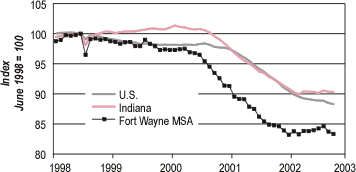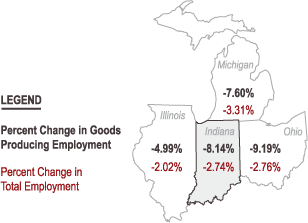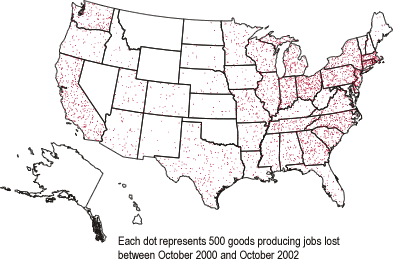Fort Wayne
Indiana University-Purdue University, Fort Wayne
After two years of decline (2000–2001) and a year of essentially no growth (2002), the Fort Wayne metropolitan area economy is forecast to have a significant cyclical bounce in 2003. The area economy consists of six counties: Adams, Allen, De Kalb, Huntington, Wells, and Whitley.
In reality, the area economy's malaise began in the summer of 1998 when manufacturing employment began a precipitous decline. Between then and the end of 2001, manufacturing employment decreased almost 13,000—or 16.8 percent (see Figure 1). The precipitous decline in manufacturing employment was not just an area phenomenon. Both Indiana and U.S. manufacturing employment declined approximately 11 percent (see Figure 1).
Figure 1
Manufacturing Employment in Fort Wayne,
Indiana, and the Nation

But the Fort Wayne area's greater percentage decline in manufacturing employment, combined with the fact that the area has a greater percentage of jobs in manufacturing, produced the almost 13,000 job loss.
Total payroll employment in the Fort Wayne area did not begin to decrease until March 2000, when the continuing decreases in manufacturing employment finally swamped the secular increases in services employment.
Area total payroll employment declined over 17,000 (6.2 percent) in twenty-five months. Starting in May 2000, payroll employment in Indiana declined 4.2 percent in twenty-five months. Starting in March 2001, U.S. payroll employment declined 1.3 percent in thirteen months.
In 2002, total payroll employment is not likely to change (from December to December). The decline in the first quarter will be offset by gains in the remaining three quarters. The U.S. recovery to date has been characterized as jobless (just as it was emerging from the 1990–91 recession). Ditto for the area recovery to date.
With respect to 2003, area payroll employment will increase between 2.0 and 2.5 percent (from December to December). That's equivalent to between 5,000 and 7,000 jobs. A principal rationale for the forecasted recovery is that because the recession was so severe locally, we will get a robust cyclical bounce.
A significant turnaround in business investment in plants and equipment during 2003 is another more fundamental reason. But to the extent that the turnaround probably will not occur before at least the second quarter of 2003, the forecasted job increase will be back-loaded.
Assuming it does occur, a robust cyclical recovery doesn't eliminate the secular problem the Fort Wayne area economy now faces. Through the last half of the 1980s and most of the 1990s, the area economy defied gravity by increasing manufacturing employment while manufacturing employment nationally continued its now three-decade decline.
Gravity now has the area economy firmly in its grasp. Of those over 17,000 jobs lost in the twenty-five-month downturn, 10,000 were in manufacturing. As already documented, the recent recession was brutal to manufacturing, both nationally and locally. Figure 2 illustrates the job losses in goods production nationally, while Figure 3 shows the percentage change for Indiana and the surrounding states.
Figure 2
Job Losses in Goods Production
October 2000 to October 2002
Figure 3
Percent Change in Employment
October 2000 to October 2002

Will the area economy again escape gravity as it did in the eighties and nineties? More importantly, why did it escape gravity? Certainly one important factor was the favorable cost of doing business in Indiana—especially vis-à-vis Michigan and Ohio. This economist will always believe that one reason General Motors chose Fort Wayne for its light-truck assembly plant in 1985 was to send a loud message to state officials in Michigan that their business costs were way out of line. That light-truck assembly plant became the flagship of a huge fleet of border-hopping manufacturing companies and entrepreneurs in northeast Indiana.
What about the current cost of doing business in Indiana? Did the recently passed tax legislation again give Indiana a competitive advantage vis-à-vis neighboring states or did it simply level a playing field that had become more and more tilted toward those states? The neighboring states got GM's message. The question fifteen years later is, "Does Indiana get the message?"
In northeast Indiana we have learned over the last four-plus years that transitioning a traditional manufacturing-based economy from 27.4 percent manufacturing employment to 24.1 percent is arduous and painful.
My hope—and my forecast—is that this latest round of transitioning has been completed.
Also in this Issue…
- Outlook for 2003
- The U.S. Economy
- The International Economy
- Financial Forecast
- Housing
- Indiana
- Anderson
- Bloomington
- Columbus
- Evansville
- Fort Wayne
- Gary
- Indianapolis
- Kokomo
- Lafayette
- Muncie
- New Albany
- Richmond
- South Bend/Mishawaka and Elkhart/Goshen
- Outlook Summary for 2003
- Return to Table of Contents




